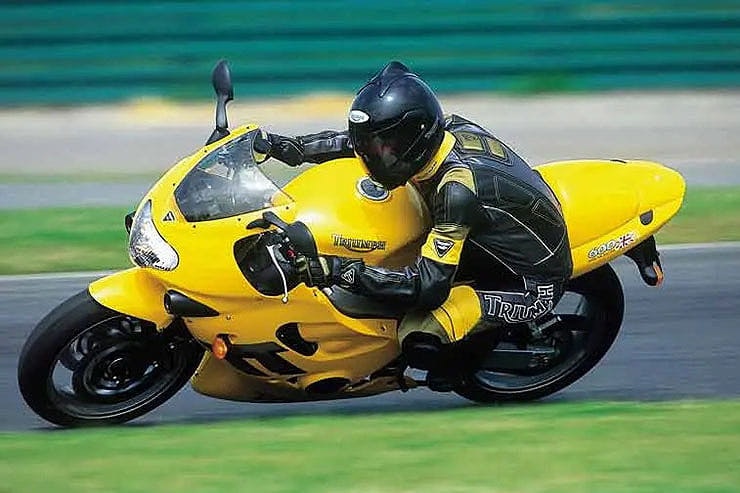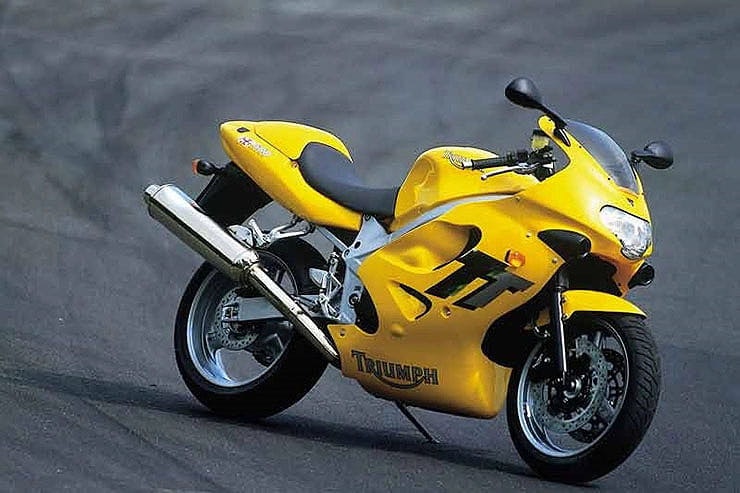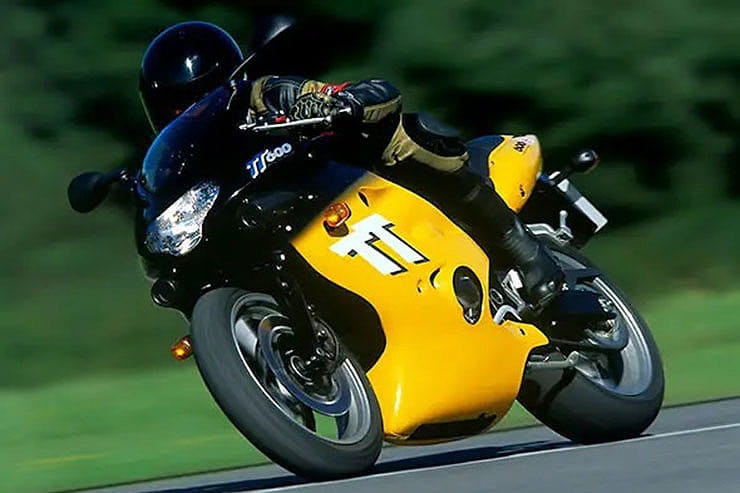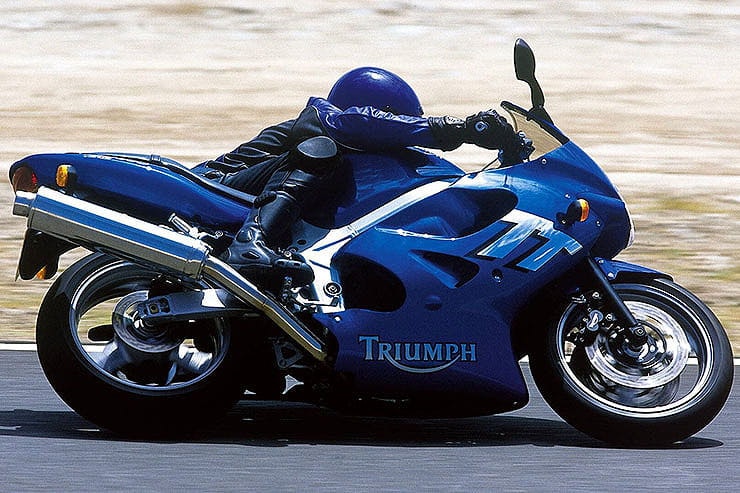Triumph TT600 (2000-2003) - Review & Buying Guide
By Jim Moore
Bike journo for a quarter of a century
21.11.2023
Price: £1700-£2800 | Power: 110bhp | Weight: 170kg | Overall BikeSocial Rating: 3/5
Triumph’s ambition knew no bounds at the start of the millennium, as the British marque stepped up to do battle with the Japanese in the most fiercely contested capacity bracket of the time: Supersport 600. Back then middleweight sports bikes formed the backbone of motorcycle sales in the UK, as well as proving hugely important to the big four in Europe and across the pond. Taking on the Japanese at their own game was no small project.
Triumph had to start from scratch with the TT, creating an all new engine, chassis, and style that moved away from its previous modular production model. In terms of numbers the TT600 landed smack-bang where it needed to be, weighing just 170 kilos, producing a claimed 110bhp, all within a wheelbase of 1395mm – the same as Honda’s CBR600F.
The TT’s chassis hit the bull’s eye, combining the rapier steering characteristics of Yamaha’s YZF-R6 and Suzuki’s GSX-R600, with the mid-corner stability and poise of the CBR. Testers at the launch raved about the TT’s on-track handling, as well as its light and responsive on-road manners. Even the bike’s performance was enough to impress.
There were issues, however. Keen to get one over its Japanese opposition, Triumph opted to fit the TT with fuel-injection – a Supersport first. The French Sagem system helped top end power but it proved problematic at lower rpm, giving the TT inconsistent and often jerky throttle response at the bottom end. The bike’s finish was also below par, with awkward styling, poorly executed colours and an overall standard of build well below that of its rivals. Triumph addressed most of these issues within a year or two, so by the end of its run the TT was able to stand shoulder-to-shoulder with its rivals.
The TT has many fans, though, sold by the bike’s excellent handling, European style and the fact that it remains a true alternative to the usual suspects. They’re incredible value, too, barely breaking the £3K mark for an absolute minter. So, if you crave a sharp handling Supersport 600 that stands out from the crowd and is kinder on your pocket than most, a Triumph TT600 has top be on your list.
Triumph TT600 (2000-2003) Price
The TT600 was in Triumph’s range for four years before being replaced by the Daytona 600 (which eventually became the Daytona 650) in 2004. Early TTs suffer from poor and inconsistent fuelling, an issue that was revisited several times during the bike’s production run. Overall specification remained the same throughout the TT’s model life, but later bikes are more sorted, nicer to ride and look better than the early two-tone examples, so are therefore worth a bit more.
2000 Triumph TT600 values:
Rough: £750 - £1100
Tidy: £1300 - £1900
Mint: £2000 - £2400
All new inline-four, aluminium beam chassis. Sagem fuel-injection (which proved problematic), 110bhp and 154mph top speed. 170kg. Distinctive two-tone ‘sprayed-in’ colour schemes. Black frame/swingarm. Colours: yellow/black, red/silver.
2001 Triumph TT600 values:
Rough: £800 - £1200
Tidy: £1500 - £2200
Mint: £2100 - £2600
Sagem fuel injection system remapped to cure low rpm fuelling issues and throttle response; new cams fitted as well. Paint schemes made cleaner and classier with single colour options. Silver frame/swingarm. Colours: yellow, black.
2002 Triumph TT600 values:
Rough: £800 - £1300
Tidy: £1600 - £2300
Mint £2300 - £2800
Further revisions to fuel injection system and ECU mapping. Colour coded air scoops. Additional black colour option added. Colours: yellow, black, blue.
2003 Triumph TT600 values:
Rough: £900 - £1400
Tidy: £1700 - £2400
Mint: £2500 - £2900
Last of the line. Black model dropped in favour of a single colour silver. Colours: yellow, blue, silver.
Sweet handling chassis
An affordable and distinctive alternative to Honda’s ubiquitous CBR
Many are owned by enthusiasts, so in nice condition
Awkward styling looked poor when new and has got worse with age
Finish isn’t as good as Japanese rivals
Fuelling not as smooth and sweet as alternatives
Triumph TT600 (2000-2003): Engine and Performance
While the TT was Triumph’s first inline-four 600, its engine architecture and design was far from revolutionary for the class. A 68 x 41.3mm bore and stroke was very similar to the CBR600’s (67 x 42.5mm), as was a 12.5:1 compression ratio (0.5 higher than the Honda). What set the TT apart, however, was Triumph’s decision to move away from carburettors and fit fuel-injection – the first on a production 600.
The TT’s Sagem electronic fuel injection system, allied to the French firm’s MC1000 engine management software, feeds fuel to the engine via four-point injectors and 38mm throttle bodies. Jerky low down throttle response was an issue from the off, however, forcing Triumph to constantly tweak the system throughout the TT’s four-year model run, even fitting new cams and making changes to the head from 2001. But even then, the fixes were never truly satisfactory.
Once out of its low rpm range, however, the TT’s throttle response and performance is a good match for its Japanese competitors, making a claimed 110bhp and 50lb.ft of torque. Above 9000rpm and through to a redline of 12,500rpm performance in impressive. Given enough room a good TT600 can break the 150mph mark, so although it’s not quite got the legs on Yamaha’s sportier and fruitier R6, in terms of overall performance it’s a good match for Honda’s CBR600F, the bike it was aiming at in the first place. A complete stainless 4-1 system was a welcome touch, too; most Japanese 600s of the time came with mild-steel pipes that’d rot in a matter of years.
Triumph TT600 (2000-2003): Handling & Suspension
If the TT600 has an ace card, it’s handling. Reviews from the track launch raved about the Triumph’s light, accurate steering and its ability to demolish corners with ease. A lightweight (just 12.6kg) aluminium beam frame using the engine as a stressed member links a 1395mm wheelbase (the same as the CBR) via fully adjustable 43mm Kayaba telescopic forks up front and a box-section aluminium swingarm and Kayaba piggyback shock at the rear – also fully adjustable. And at 170kg dry, the TT was also bang-on where it needed to be in terms of weight.
Sweet handling, quality Japanese suspension and a powerful braking set-up (310mm discs and 4-pot Nissin calipers and braided lines as standard) gave the TT a reputation as a brilliant back road scratcher and an exciting track bike – both disciplines that barely dip into the bike’s troublesome low rpm fuelling. With a rake/trail of 24°/82mm the TT is one of the fastest turning 600s of its time, too.
Even in used form, the basis for thrills is still very much there with a TT600. Fettle the suspension, ensure the brakes are as sharp as intended and every ride, short or long, should tickle your adrenal gland. It’s telling too that Triumph kept the TT’s chassis for its successor, the more angular and visually pleasing Daytona 600/650.
Triumph TT600 (2000-2003): What to look for
Jerky throttle response: The TT was the first production 600 to feature fuel injection, and Triumph was new to the tech at the time, so problems were perhaps inevitable. Jerky and inconsistent throttle response, especially at low rpm, was an issue with TTs – particularly early bikes. Triumph remapped the Sagem system several times throughout the TT’s model life, so later bikes (2002/2003) are a better bet, although many owners of 2000/01 machines got the issue addressed by dyno experts.
Questionable finish: In many respects the TT600 looked rushed to market. A lot of the bike’s casting (footpegs hangers, brackets etc) and plastics looked cheap and quickly showed wear and tear. Fairing tangs snap off, pillion footrest hangers corrode, the cockpit looks messy, and we’ve even known side stands to simply fall off. Condition is everything with a TT600.
Reg/rec and generator: TT600 electrics aren’t that strong. Reg/rec units fail with tedious regularity, much to the annoyance of owners. Wiring between the stator and reg/rec can overheat and melt, too. Ask the seller when (rather than if…) the reg/rec was last changed and what electrical issues they’ve experienced. Looms can also have been butchered – the TT comes from a time when Datatool alarms were commonplace and fitment/removal of these units can leave the loom badly scarred.
Engine: Not a bad unit, although nothing out of the ordinary in terms of design, but some bikes have suffered complete engine failure, so be mindful of rattles, knocks, smokey emissions or tuning. A standard bike with a service history and an owner with some level of mechanical sympathy is the preferred option.
Stalling: An annoying and sometimes hard to diagnose issue. Oil blowback through the breather into the Idle Air Control valve can cause this symptom, as can kinked breather/fuel pipes, faulty fuel pumps, and ECU issues – all reported by TT600 owners.
Suspension: Even the newest TT600 is going to be 20 years old by now, so a fork/shock overhaul would be well advised, if it’s not been done already. A quality replacement shock, like a Nitron, Wilbers or Hyperpro will cost upwards of £550 and a fork rebuild with fresh oil, new springs etc will rush you from £350. All money well spent.
Triumph TT600 (2000-2003): Rivals
Honda CBR600F, 2000 | Approx Price: £1500 - £3000
Power/Torque: 110bhp/48lb-ft | Weight: 168kg
Brilliant all-rounder and the inspiration for the TT600. Better finished than the Triumph and a better overall package. Has aged far better than the TT. Still a superb Supersport 600 if you can find one in tidy, well maintained condition.
Kawasaki ZX-6R, 2000 | Approx Price: £1500 - £2800
Power/Torque: 109bhp/49lb-ft | Weight: 171kg
Sportier than the CBR, more practical than an R6. Strong engine, decent handling and race pedigree, but suspension, throttle response and overall feel gets baggy over time. A better package than the TT, although not quite as sweet handling.
Yamaha YZF-R6, 2000 | Approx Price: £1500 - £3300
Power/Torque: 115bhp/48lb-ft | Weight: 169kg
The racy 600 of the era. All aluminium chassis, sporty suspension and a peaky motor make for a fun ride, but most R6s tend to have been thrashed, so check for oil consumption, crash damage and poor maintenance. Avoid ex-race bikes like the plague; they’ll be rubbish unless you’re after a cheap track hack.
Triumph TT600 (2000-2003): Verdict
Although the TT600 undoubtedly had its issues, it still offers something different to its Japanese rivals and remains, along with its replacement, Europe’s only four-cylinder Superport 600. Get a later model with sorted fuelling and revel in the sharpest steering, finest handling 600 chassis of its era.
If you’d like to chat about this article or anything else biking related, join us and thousands of other riders at the Bennetts BikeSocial Facebook page.
Triumph TT600 (2000-2003) - Technical Specification
Looking for motorcycle insurance? Get a quote for this motorbike with Bennetts bike insurance



